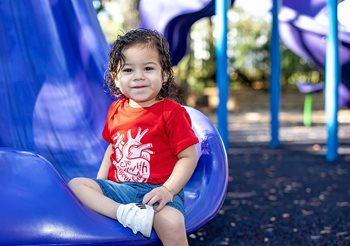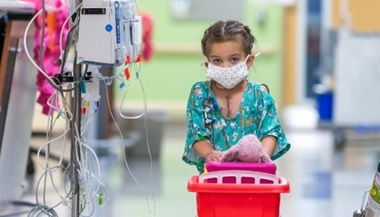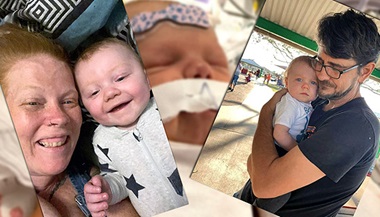Patient Story
Transposition of the Great Arteries (TGA): Emmanuel’s Story
Patient Story Highlights

With three months left to go before the arrival of her second child, Casandra got some heartbreaking news. Her baby boy, Emmanuel, would be born with critical heart defects that would require surgery and long-term medical care.
Though It wasn’t the first time she had faced trauma surrounding the birth of a child, nothing prepares a parent for a second child with critical health issues. Her first son, Miguel, had been born just after 24 weeks of gestation and weighed 1 pound and 9 ounces. After spending five months in the neonatal intensive care unit of a local hospital, he was transferred to Johns Hopkins All Children’s Hospital in St. Petersburg, Florida, where surgeons closed an opening of the two main blood vessels leaving his heart. Today, Miguel is a healthy, happy 4-year-old.
Still, “I was scared; I was devastated,” Casandra recalls about learning about the health challenges her second son would face.
Prenatal Tests
Prenatal tests painted a concerning picture: Emmanuel had transposition of the great arteries (TGA), with ventricular septal defect. That’s a condition in which the aorta, the artery that is supposed to take oxygen-rich blood to the body, and the pulmonary artery, which is supposed to take oxygen-poor blood to the lungs to be oxygenated, have switched places. As a result, under-oxygenated blood gets sent to the body, while blood rich with oxygen gets sent to the lungs.
A ventricular septal defect happens during pregnancy if the wall that forms between the two ventricles, lower heart chambers, does not fully develop, leaving a hole. This causes too much blood to get pumped into the lungs and can result in trouble breathing and poor weight gain as well as pulmonary hypertension in larger holes that go uncorrected. He also had an abnormal left pulmonary valve, as well as deep vein thrombosis, also known as blood clots in the veins.
Full-term Birth
Despite these heart issues, Emmanuel was born full term on July 26, 2021 and weighed a healthy 7 pounds, 8 ounces.
Doctors at the Tampa hospital where he was born started him on medicines to see if those would help stabilize his heart until he could safely undergo surgery. A month later, Emmanuel underwent surgery at the local hospital, where doctors re-directed all the blood in his heart to the correct locations and reconstructed the main arteries that carry blood from the heart to the lungs.
“He took it on like a champ,” his mother recalls.
Though still facing challenges, Emmanuel smiled often and learned to roll over like other children.
“He was a happy baby,” Casandra says.
One day in February 2022, when Emmanuel was 7 months old, his mother noticed his skin had paled. He was having trouble breathing and experienced seven vomiting episodes.
“He looked so weak, closed his eyes and drooped,” she says. “It looked like someone had sucked his soul out of his body.”
Heart Failure
Emmanuel was rushed to another local hospital, where doctors ran tests and diagnosed him with heart failure. He also tested positive for COVID-19 as well as adenovirus and myocarditis, an inflammation of the heart muscle. Complicating matters, the squeeze of his heart was severely depressed.
Doctors at that hospital started him on infusions to aid heart function, but when Emmanuel didn’t respond, they recommended a heart transplant and referred the family to Johns Hopkins All Children’s, where he was admitted on Valentine’s Day. The St. Petersburg hospital’s Heart Institute offers the only pediatric heart transplant program on Florida’s west coast. Its board-certified heart surgeons work closely with a multidisciplinary team to treat children with congenital heart defects and provide consistent care from diagnosis through follow-up.
A Compressed Artery
“When Emmanuel arrived, we performed an ultrasound of his heart, also known as an echocardiogram,” says Zachary Coffman, M.D., a board-certified cardiologist who works in the cardiovascular intensive care unit at Johns Hopkins All Children’s. “An echo can provide a lot of information about the anatomy and function of a heart, and his echo showed that his heart did not appear to be squeezing normally and it was difficult to see several arteries that are normally fairly well-seen.”
Because of the difficulty in seeing these arteries, the medical team took Emmanuel for a cardiac catheterization to get a much closer look. This is a procedure in which an interventional cardiologist guides a long, thin tube through the blood vessels, usually through a tiny incision in the groin area, neck or wrist, using imaging to guide the catheter. It allows the cardiologist to measure things like blood pressure, oxygen levels and blood flow, to examine the structure of the heart and to treat a range of congenital defects.
Additional tests included a computerized tomography or CT scan, a series of X-ray images taken from around the body and uses computer processing to see cross-sectional images of bones, blood vessels and soft tissues.
According to Coffman, it showed an area of Emmanuel’s left coronary artery that seemed to be compressed. The CT scan showed a severely enlarged aneurysm of the main pulmonary artery, which carries blood from the heart toward the lungs.
“This enlarged artery appeared to be compressing one of Emmanuel’s coronary arteries, which could explain why his heart was not functioning well,” Coffman explains. “Coronary arteries supply blood and oxygen to the heart itself, so compressing one deprives the heart muscle of blood flow and oxygen.”
Coffman says Emmanuel’s aneurysm is “very rare” and even more unusual to see it compress a coronary artery.
“This was an unexpected and unfortunate complication likely related to a weakened vessel wall,” he says.
A Surgical Fix
To save Emmanuel’s heart, the team turned to James Quintessenza, M.D., co-director of the Heart Institute and chief of cardiovascular surgery at Johns Hopkins All Children’s. Dr. Q, as he is affectionately nicknamed, was one of the cardiothoracic surgeons who performed the hospital’s first pediatric heart transplant in 1995.
“Dr. Quintessenza explained everything thoroughly; he was very confident that he was going to do everything in his doctoral powers to save my baby's heart, which thankfully he did,” Casandra says.
The award-winning surgeon removed and repaired parts of Emmanuel’s enlarged pulmonary arteries before placing an artificial conduit from the heart’s right ventricle to the newly repaired pulmonary arteries. A conduit is an artificial tube that can be made from different materials. In Emmanuel’s case, it serves to carry blood from his heart out to his lungs and replaced the artery that was compressing his coronary artery. This allowed the coronary artery to re-open and supply blood to the heart.
The surgery went smoothly, though Casandra recalls a few tense moments during recovery. A lung collapsed, requiring the temporary use of a machine to help him breathe.
Compassionate Care
Through it all, Sandra Vizer, R.N., stayed at Emmanuel’s side.
In addition to providing skilled and compassionate nursing care, she read books, sang songs, and played with Emmanuel during the times his family had to be away. When Cassandra was present, Vizer helped her hold her son safely while he was connected to medical devices and let her help bathe him.
“I can only imagine how difficult it is for our families to see their children in such critical condition, so I did everything I could to ease this experience for her, listening to her stories and providing Emmanuel with the most meticulous and compassionate care that I possibly could,” Vizer says, adding that as he recovered, he smiled and became alert and active.
“Emmanuel was such a happy patient that if it weren't for the hospital setting, you may not have known he was sick,” she says.
Casandra says Vizer and the entire team at Johns Hopkins All Children’s treated her and Emmanuel “like family.” She says she is grateful to Quintessenza and his surgical expertise that allowed her son to avoid a transplant and keep his own heart.
“He deserves the biggest shout out for having such high hopes and being the most positive and confident doctor I have ever met in my life who went above and beyond to save my son’s original heart,” she says.
She also thanked Coffman for his skill in diagnosing Emmanuel and keeping her informed.
“He explained anything and everything that was happening with Emmanuel and made sure I understood,” she says.
She also heaped high praise upon the nursing staff, particularly Vizer.
“She was an angel and took extremely good care of Emmanuel as if he were her own,” Casandra says. “Every time I would go to see him…I would come in with joy knowing my baby was in great hands.”
After a month-long stay, Emmanuel and his family were sent home with cheers and hugs. He receives follow up care at Johns Hopkins All Children’s every three months.
Casandra says Emmanuel, who is set to turn 2 in July, is now able to crawl, cruise, eat regular foods, drink milk and sit up on his own.
He also loves playing with his big brother.
Casandra is thankful that Johns Hopkins All Children’s was there for her older son as well as Emmanuel, whose middle name, Angel, was “inspired by him being my second miracle angel baby that was sent from above.”






